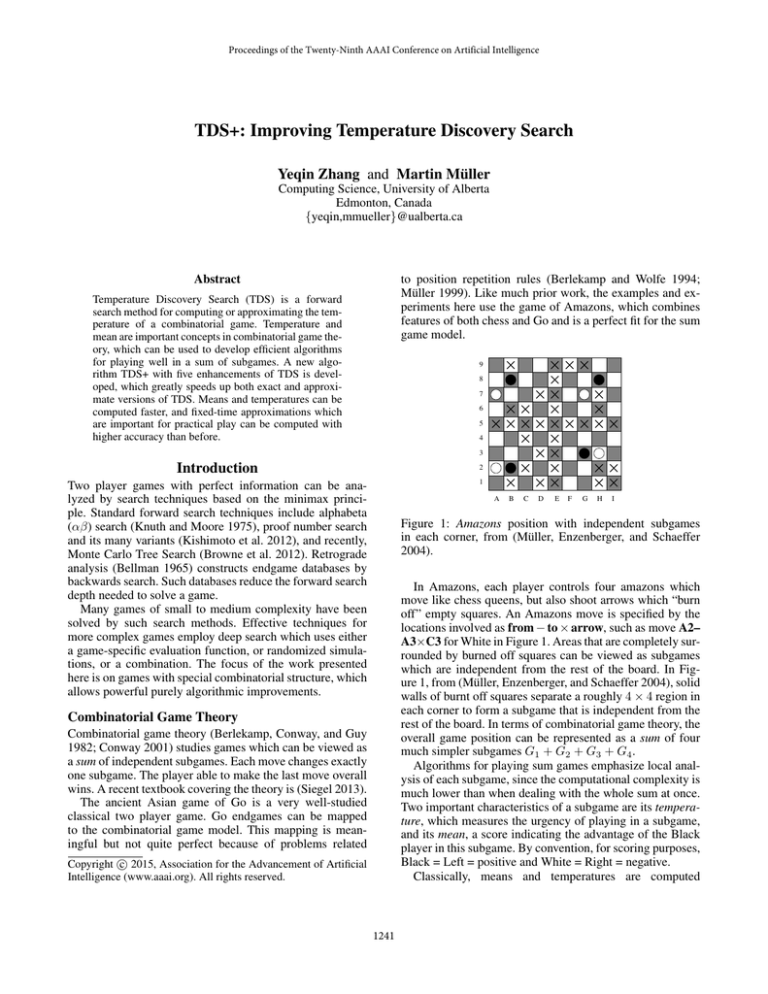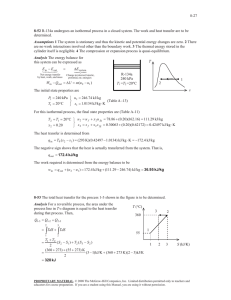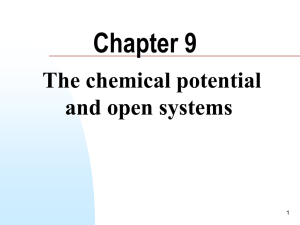
Proceedings of the Twenty-Ninth AAAI Conference on Artificial Intelligence
TDS+: Improving Temperature Discovery Search
Yeqin Zhang and Martin Müller
Computing Science, University of Alberta
Edmonton, Canada
{yeqin,mmueller}@ualberta.ca
Abstract
to position repetition rules (Berlekamp and Wolfe 1994;
Müller 1999). Like much prior work, the examples and experiments here use the game of Amazons, which combines
features of both chess and Go and is a perfect fit for the sum
game model.
Temperature Discovery Search (TDS) is a forward
search method for computing or approximating the temperature of a combinatorial game. Temperature and
mean are important concepts in combinatorial game theory, which can be used to develop efficient algorithms
for playing well in a sum of subgames. A new algorithm TDS+ with five enhancements of TDS is developed, which greatly speeds up both exact and approximate versions of TDS. Means and temperatures can be
computed faster, and fixed-time approximations which
are important for practical play can be computed with
higher accuracy than before.
9
8
7
6
5
4
3
Introduction
2
Two player games with perfect information can be analyzed by search techniques based on the minimax principle. Standard forward search techniques include alphabeta
(αβ) search (Knuth and Moore 1975), proof number search
and its many variants (Kishimoto et al. 2012), and recently,
Monte Carlo Tree Search (Browne et al. 2012). Retrograde
analysis (Bellman 1965) constructs endgame databases by
backwards search. Such databases reduce the forward search
depth needed to solve a game.
Many games of small to medium complexity have been
solved by such search methods. Effective techniques for
more complex games employ deep search which uses either
a game-specific evaluation function, or randomized simulations, or a combination. The focus of the work presented
here is on games with special combinatorial structure, which
allows powerful purely algorithmic improvements.
1
A
B
C
D
E
F
G
H
I
Figure 1: Amazons position with independent subgames
in each corner, from (Müller, Enzenberger, and Schaeffer
2004).
In Amazons, each player controls four amazons which
move like chess queens, but also shoot arrows which “burn
off” empty squares. An Amazons move is specified by the
locations involved as from − to × arrow, such as move A2–
A3×C3 for White in Figure 1. Areas that are completely surrounded by burned off squares can be viewed as subgames
which are independent from the rest of the board. In Figure 1, from (Müller, Enzenberger, and Schaeffer 2004), solid
walls of burnt off squares separate a roughly 4 × 4 region in
each corner to form a subgame that is independent from the
rest of the board. In terms of combinatorial game theory, the
overall game position can be represented as a sum of four
much simpler subgames G1 + G2 + G3 + G4 .
Algorithms for playing sum games emphasize local analysis of each subgame, since the computational complexity is
much lower than when dealing with the whole sum at once.
Two important characteristics of a subgame are its temperature, which measures the urgency of playing in a subgame,
and its mean, a score indicating the advantage of the Black
player in this subgame. By convention, for scoring purposes,
Black = Left = positive and White = Right = negative.
Classically, means and temperatures are computed
Combinatorial Game Theory
Combinatorial game theory (Berlekamp, Conway, and Guy
1982; Conway 2001) studies games which can be viewed as
a sum of independent subgames. Each move changes exactly
one subgame. The player able to make the last move overall
wins. A recent textbook covering the theory is (Siegel 2013).
The ancient Asian game of Go is a very well-studied
classical two player game. Go endgames can be mapped
to the combinatorial game model. This mapping is meaningful but not quite perfect because of problems related
c 2015, Association for the Advancement of Artificial
Copyright Intelligence (www.aaai.org). All rights reserved.
1241
the temperature tmax of the largest coupon is too small. This
is indicated by a principal variation (PV) of the αβ search
which starts with a move in G, not a coupon.
Approximate TDS uses a larger value of δ than required
by theory. It was shown to yield excellent approximations of
means and temperatures even with relatively large δ such as
1
2 . In experiments on sums of Amazons positions, a heuristic TDS-based algorithm outperformed global αβ search for
sums of Amazons subgames.
Let G be a (sub)game to be analyzed. A search state in
TDS is defined as S(g, c, ∆, toPlay), where g is the current game position reached by play from G, c is the current
coupon stack, ∆ is the aggregate score of all coupons already taken, with coupons taken by White counted negative,
and toPlay is the color to play next. A move in g changes the
state to a board position g 0 , while a move in c changes both
the coupon stack and ∆. Any move also changes toPlay to
the opponent.
bottom-up from terminal positions, using the thermograph
structure, which contains enough information to determine
both these measures (Berlekamp, Conway, and Guy 1982).
Two forward search approaches for computing means
and temperatures are known. Mean and Temperature Search
(MTS) (Kao 2000; Kao et al. 2012) searches a subgame in
alternating-first order and refines bounds on means and temperatures up to convergence. The main limitation of MTS
is the requirement that all game positions of temperature
zero and below can be statically recognized and evaluated.
In many combinatorial games, including Amazons, this is
not feasible. The remainder of this paper focuses on improving the other known forward search algorithm, Temperature
Discovery Search (TDS) (Müller, Enzenberger, and Schaeffer 2004), which can handle any loopfree game including
those with nonpositive temperature.
Enriched Environment, Coupon Stack and
Temperature Discovery Search (TDS)
Motivating Example for Improving TDS
Local analysis of a single subgame can utilize an enriched
environment (Berlekamp 1996; 2000) consisting of elementary switches, simple subgames of the form v| − v for some
number v. In v| − v, Black to move can gain v extra moves,
while White to move can also gain v moves which is scored
as −v by the convention above. The mean of such a switch
is µ(v| − v) = 0 and its temperature is t(v| − v) = v
(Berlekamp, Conway, and Guy 1982). Sum games consisting only of such switches are very easy - playing a switch
with highest temperature v is always optimal. Following
(Berlekamp 1996), coupon stacks can be extended to cover
negative temperatures down to the lowest possible temperature of -1. A sum game consisting of a single, potentially
complex, subgame G plus an enriched environment called a
coupon stack can be used to determine both the mean and
temperature of G (Berlekamp 1996).
Given δ > 0 and tmax = nδ for some integer n such
that nδ ≥ −1, an extended coupon stack C(tmax , δ) contains
coupons of value tmax , tmax − δ, · · · , −1, followed by a sufficiently large number k of final coupons of value -1, and a
“balancing” coupon of value − 21 . If tmax > −1, the current
player can take the top coupon of value tmax in C(tmax , δ).
This changes the score of the game by ∆ = tmax in that
player’s favor and leaves a shorter stack C(tmax −δ, δ). When
tmax = −1, a player can take a coupon of value −1 in this
final coupon stack. The number k of extra coupons should
be chosen large enough that there is always such a coupon
available while play in G continues. A coupon stack C =
C(tmax , δ) with tmax ≥ 0 behaves like a combinatorial game
of temperature t(C) = tmax and mean µ(C) = 0. For any
tmax ≥ −1, the left score, the minimax score with alternating play and Left going first, is V (C, Left) = d n2 eδ while the
right score with Right going first is V (C, Right) = −d n2 eδ.
Temperature Discovery Search (TDS) (Müller, Enzenberger, and Schaeffer 2004) is a forward search algorithm
based on αβ search of the sum G + C, where G is the game
to be analyzed and C is a coupon stack. Taking a coupon
of value v is represented by C(v). With a small-enough δ
and large-enough tmax , TDS computes exact means and temperatures for loopfree combinatorial games. TDS can fail if
3
×
×
×
2
×
1
a
b
c
Figure 2: Amazons example where TDS scales badly for
small δ.
The main problem of applying the original TDS algorithm
in practice is its time complexity when scaling up - either
to larger subgames, or higher precision using smaller δ. As
an illustration, consider the game G in Figure 2 with temperature t(G) = 54 . As an approximation algorithm with a
relatively large δ = 1/2 and setting tmax = 2+δ, TDS is reasonably fast and computes the following principal variation
(PV) with Black going first:
1. C( 25 ) 2. C( 42 ) 3. C( 32 ) 4. A1–A2×B1 5. C( 22 )
6. C( 12 ) 7. C(0) 8. C(− 21 ) 9. C2–B3×C2.
The first move on the board is played at move 4, between
coupons of value 32 and 1. This represents a good approximation to t(G) = 54 and is achieved with a relatively fast 9-ply
search1 . However, computing the exact temperature requires
setting δ = 1/8. This leads to a deep 23-ply search with the
following PV:
16
15
14
13
1. C( 17
8 ) 2. C( 8 ) 3. C( 8 ) 4. C( 8 ) 5. C( 8 )
11
10
12
6. C( 8 ) 7. C( 8 ) 8. A1–A2×B1 9. C( 8 ) 10. C( 98 )
11. C( 88 ) 12. C( 78 ) 13. C( 68 ) 14. C( 85 ) 15. C( 84 )
16. C( 38 ) 17. C( 28 ) 18. C( 18 ) 19. C(0) 20. C(− 18 )
21. C(− 82 ) 22. C(− 38 ) 23. C2–B3×C2.
This optimal line of play contains two long coupon-taking
subsequences but only two moves (8 and 23) on the game
1
For simpler presentation, we ignore the mechanism for handling sente moves in this example. For details, see (Müller, Enzenberger, and Schaeffer 2004).
1242
same after either sequence ab or ba played from G. Then
the move sequence ending with successive -1 coupons:
1. Black a 2. White b 3. Black C(−1) 4. White C(−1)
is a PTP which is evaluated as 0, while the sequence:
1. Black C(−1) 2. White b 3. Black a 4. White C(−1)
is not and might have a different minimax score. Both
sequences result in identical board positions G0 and coupon
stacks c−1 , but their evaluation is not the same in general.
In the original TDS algorithm, this problem is avoided since
the transposition table is only used in a very conservative
way: states reached after consecutive -1 coupons are never
stored or looked up in a table. The more agressive use
of tables in TDS+ requires handling the GHI problem
above. While efficient general solutions exist (Kishimoto
and Müller 2004), for the current special case it suffices
to slightly extend search states by storing the number of
consecutive -1 coupons taken as the most recent moves.
Instead of storing both states resulting from the two
sequences above as S(G0 , c−1 , ∆, Black), which would
cause a GHI problem, the extended states become distinct:
S(G0 , c−1 , ∆, Black, 2) and S(G0 , c−1 , ∆, Black, 1).
board. Moves 1–7 are all coupons since the initial temperature tmax = 17
8 of the coupon stack is considerably higher
than the board temperature of 54 . After the first board move
8. A1–A2×B1, the temperature of the board drops to − 12 ,
and therefore all moves 9–22 are again coupons.
In the simple standard model with fixed branching factor b and fixed depth d, the best case time complexity of
αβ search is Θ(bdd/2e ). Compared to an αβ search of G
without a coupon stack, b increases by one in TDS for the
added coupon move. However, d increases by the number of
coupons that need to be taken before reaching a terminal position in G, which can be very large when δ is small and tmax
increases. The number of coupons in a coupon stack is about
(tmax + 1)/δ, plus possibly several final coupons of value -1.
One important improvement implemented in the original
TDS, and used in the example above, is that as soon as a
recognized terminal position is reached in G, TDS stops the
search and computes the alternating-play value of the remaining coupons. To improve the speed of TDS in practice,
reducing the search depth is essential. The TDS+ algorithm
developed in the following section achieves this while retaining correctness.
Conditional Move Generation
The TDS+ Algorithm: Speeding up TDS
Algorithm 1 Conditional Move Generation using a
temperature-dependent Skip() test.
1: function C ONDITIONAL G ENERATE(G, C, Skip)
2:
t := MaxTemperature(C)
3:
if Skip(t, G) then
4:
return {C(t)}
5:
else
6:
return {C(t)} ∪ Generate(G)
7:
end if
8: end function
The approaches to improving TDS in this paper are based on
three main insights: 1. reducing the effective search depth
can be achieved by avoiding long sequences of coupons,
both at the beginning and in the middle of a search. 2. fast
pre-searches with a large value of δ can be used to quickly
gain information about a game, in order to set up the final,
expensive search as well as possible. 3. the fact that a sum
G + C is searched can be used for strong algorithm-specific
improvements to the transposition table, which allow much
better re-use of information compared to the “plain αβ”
transposition table used in the original TDS algorithm. However, some care is needed to handle this re-use correctly, as
discussed in the next section.
Several of the enhancements below work by suppressing
move generation in the game G for specific temperatures
t. In principle, coupons at these temperatures could be removed from the coupon stack, but the bookkeeping for
stacks with nonuniform temperature differences becomes
messy. In Algorithm 1, a uniform δ stack is retained, but
move generation in G is skipped at these temperatures, resulting in a very fast unbranched search step. Enhancements
E2 and E4 below utilize this approach, with different S KIP
functions.
Re-using State Information and Solving a
TDS-specific Graph History Interaction Problem
The graph history interaction (GHI) problem occurs when
the outcome of a game depends on the path (history) of
moves from the initial state. The most frequent example of
this problem are rules for handling position repetition. Surprisingly, GHI can appear when searching G + C even when
a game G itself has no history dependency.
Play of G + C ends either in a normal terminal position,
where the value of G can be statically recognized, or in a
pseudo-terminal position (PTP), where both players took a
-1 coupon as their last move, indicating their unwillingness
to continue play. PTP are evaluated as 0 by the simplicity
rule of combinatorial game theory (Berlekamp, Conway, and
Guy 1982; Müller, Enzenberger, and Schaeffer 2004). PTP
can cause a GHI problem as follows:
Let δ be fixed, and let c−1 = C(−1, δ) be a final coupon
stack with tmax = −1. Consider playing G + c−1 with
Black to play, when there exist moves a for Black and b
for White such that the resulting board position G0 is the
The Five Enhancements of TDS+
The following five enhancements lead from TDS to an improved algorithm TDS+.
E1 : Fast Pre-Searches With Decreasing Values of δ
The original TDS sets tmax = bound + δ, where bound is
a game-specific bound on the maximum possible temperature. In Amazons, a safe bound for a position with n empty
squares is n − 1. However, the temperature of most positions is much lower. As for Figure 2, searching with a larger
δ is much faster and can be used to obtain a better tmax
estimate. Extensive empirical testing showed that the estimated temperature returned from such searches never un-
1243
derestimates by much, giving rise to the 2δ-Conjecture: Let
tδ = TDS (G, δ, tmax ) be the approximate temperature computed for some δ. Then the true temperature t(G) is upper
bounded by t(G) ≤ tδ + 2δ.
Algorithm 2 shows TDS with enhancement E1 . G
is searched repeatedly with decreasing values of δ =
1, 12 , · · · , 21n , while adapting tmax along the way. Since the
2δ-conjecture is unproven, the call to TDS in Line 5 of the
algorithm could possibly fail. In this case, the algorithm
needs to re-search with tmax = tδ + 3δ, tmax = tδ + 4δ, etc.
until it succeeds. This case has never happened in thousands
of experiments, and is not shown in the pseudocode. Choosing a lower position-dependent tmax means fewer coupons
in the final, most expensive search. In the ideal case the PV
starts with a single coupon, followed by a move in G.
of its hash function for coupon stacks did not allow re-use
of information between searches. The generalized transposition table of TDS+ improves upon TDS in three ways: First,
TDS+ computes the hash code for a stack c by first defining
a hash function mapping each temperature t to a hash code
h(t), then defines the hash code of c as the bitwise xor of the
codes of all coupons with temperature t > −1. Second, in
order to deal with GHI, the hash code encodes the number
of consecutive −1 coupons taken. This allows re-use of hash
table entries between different searches.
Third, TDS+ generalizes the entries in the hash table as follows: The minimax value of a full state
S(g, c, ∆, toPlay, nuFinal-1Coupons) is the sum of the aggregate value ∆ of coupons taken so far, and its remaining value, which depends on the other state variables g, c,
toPlay and nuFinal-1Coupons. In the TDS+ hashtable, states
are stored without encoding ∆, and this value is kept up
to date incrementally in a search while traversing the game
tree, and is added to each value retrieved from the hash table. In this way, a state s0 that has different past history in
terms of coupons taken but is the same otherwise as a state
s can be used to compute the value of s without search.
E4 : Recursive TDS
While enhancement E1 is designed to lower tmax and avoid
search at too-high temperatures at the beginning of the
search, the same idea can be applied recursively after each
move on the board, since the temperature may have dropped
significantly. Enhancement E4 , shown in Algorithm 4, recursively calls TDS1 to compute a tmax estimate at every position during the search. In case of a temperature drop, this
approach can skip many coupons in the top-level search.
Algorithm 2 TDS1 : Pre-searches with δ from 1 to 2−n
1: function TDS1 (G, n)
2:
δ := 1
3:
tmax := safe bound(G)
. n − 1 in Amazons
4:
while δ > 2−n do
5:
tδ := TDS(G, δ, tmax )
6:
tmax := tδ + 2δ . Adapt tmax for next iteration
7:
δ := δ/2
8:
end while
9:
return TDS(G, δ, tmax )
10: end function
E2 : Avoid Search at Impossible Temperatures
The birthday b(G) of a loopfree game G is a measure for its
recursive depth (Siegel 2013). G is said to be born by day
n if b(G) ≤ n. For an Amazons position G with n empty
squares, b(G) ≤ n. For fixed n, the set of games born by day
n is finite. In unpublished work, the authors recently proved
the following theorem which restricts the sets of possible
temperatures and means of loopfree games born by day n.
Theorem 1 For a game born by day n ∈ N, its temperature
is contained in the set Tn = {− 21b , 0, 21b , 23b , . . . , a+ 21b |0 ≤
a ≤ n − 2, 0 ≤ b ≤ n − 1}, and its mean in the set
Mn = {0, ± 21b , ± 23b , . . . , ±(a + 21b ), ±n|0 ≤ a ≤
n − 2, 0 ≤ b ≤ n − 1}
Algorithm 4 Lower the temperature at internal nodes
1: function S KIP -R ECURSIVE(t, G)
2:
n := BirthdayUpperBound(G)
3:
return t >TDS1 (G, n)
4: end function
E5 : Improved Handling of PTP States
With E5 , PTP states reached after two consecutive -1
coupons are recognized as solved positions.
Experiments
Algorithm 3 Skipping Impossible Temperatures
1: function S KIP -I MPOSSIBLE - T(t, G)
2:
n := BirthdayUpperBound(G)
3:
return t 6∈ Tn
4: end function
All experiments use the game of Amazons and are performed on a 2.4 GHz Intel Xeon. The maximum memory
in the experiment is 80 MB.
Improvement from Individual Enhancements
TDS+ corresponds to the original TDS algorithm plus all
enhancements E1 –E5 . This section investigates the performance of different subsets of enhancements. The presence
of enhancement Ei is indicated by adding i to the subscript
of TDS. For example, TDS13 uses E1 and E3 , and TDS+ is
TDS12345 . Not all subsets are meaningful, since E4 requires
both E1 and E3 , while E5 requires E3 . The test set contains
600 cases from a complete database of 4 × 4 Amazons positions with one queen each: 17 cases with two empty squares,
Enhancement 2 directly applies this theorem using the
S KIP -I MPOSSIBLE - T function in Algorithm 3 as the argument Skip in C ONDITIONAL G ENERATE of Algorithm 1.
This test requires an estimate of the birthday of a game G.
Especially for small δ, many temperatures can be skipped.
E3 : Generalized Transposition Table
The original TDS implementation uses a standard hash table to recognize transpositions in its αβ search. The design
1244
33 cases with 14 empty squares, and 50 test cases each for
3 to 13 empty squares. These were randomly sampled from
the database. Experiments were performed to test interesting subsets of enhancements, including each enhancement
in isolation, as well as a leave-one-out setting. Table 1 shows
the results in terms of coverage, or number of problems
solved, with different time limits.
Time
TDS
TDS1
TDS2
TDS3
TDS134
TDS35
TDS13
TDS235
TDS1345
TDS12
TDS1235
TDS1234
TDS12345
1s
69
78
69
73
81
73
99
73
82
78
96
83
82
2.5s
73
88
73
76
108
76
117
77
109
89
118
111
111
10s
73
100
73
85
129
86
130
91
129
100
130
133
133
25s
74
107
75
95
135
96
131
102
135
108
135
136
136
100s
76
116
76
117
137
117
136
117
137
116
150
153
153
250s
76
116
76
117
141
117
141
117
141
116
157
157
159
Figure 3: Runtime comparison, TDS1235 vs TDS12345
Table 1: Coverage for selected subsets of TDS enhancements. Results for: plain TDS, individual enhancements,
TDS13 , leave-one-out, and full TDS+. E4 and E5 require
other enhancements to work.
Discussing the contribution of each enhancement from the
results in the table, TDS1 already solves many more test
cases than TDS. However, its scaling with higher time limits
is also poor. Comparing TDS235 with TDS1235 shows that
E1 is also very strong in combination.
Results for TDS2 show that E2 alone helps little. However, combined with other enhancements it works very well
for more complex test cases, as shown by the big difference
between TDS1345 and TDS12345 for longer time limits.
The individual strength of E3 is similar to E1 , as seen
when comparing TDS1 and TDS3 , and also TDS235 and
TDS12 . These two combine very well in TDS13 , and also
in TDS1235 compared to both TDS235 and TDS12 .
Adding E4 is a strong improvement over E3 alone but not
over TDS13 . TDS12345 and TDS1235 also have similar coverage. TDS12345 can solve more high temperature test cases.
Figure 3 shows details. For high temperature test cases with
t(G) ≥ 2, TDS12345 is always faster than TDS1235 . Since
not all larger size test cases with 6 or more empty squares
have high temperature, TDS1235 can finish some of them
faster than TDS12345 .
Figure 4 gives further evidence that reducing the number
of top coupons as in E1 is important. In this experiment,
TDS+n
135 is TDS135 but with n extra top coupons of value
tmax +δ, · · · , tmax +nδ added after determining tmax with enhancement E1 . For all test cases with runtime over 1 second,
TDS135 is fastest. Only cases where all experiments finished
within the time limit are shown. Out of the 144 test cases that
completed with TDS135 , the number of extra timeout cases
was 3, 5, 8, 8 for n = 1 . . . 4. Runtimes are plotted on a log
scale in Figure 3 and 4.
Figure 4: Runtime comparison, TDS135 vs. TDS+n
135
The improvement from E5 is modest. As an example,
TDS12345 expands 0.5% fewer nodes than TDS1234 over the
set of all 50 test cases with 5 empty squares.
Approximation Error of TDS+ with Larger δ
Two experiments compare the approximate version of TDS
and TDS+. The first experiment in Table 2 shows the coverage on the test set for fixed values of δ and fixed time limits.
TDS+ finishes substantially more test cases than TDS for
each tested combination of δ and time limit. Note that the
difference in coverage fluctuates a bit, as clusters of problems with similar difficulty can occur.
The second experiment measures approximation errors
for temperature and mean when varying the time limit. Figure 5 shows that both mean and temperature are approximated better by TDS+ than by TDS. If a test case times
out, different approximations to the temperature are feasible based on the PV of the incomplete search. As in TDS,
if the PV contains a board move, the prior coupon value is
chosen as the temperature. In case there is no board move
1245
δ=1
TDS
TDS+
δ = 1/2
TDS
TDS+
δ = 1/4
TDS
TDS+
δ = 1/8
TDS
TDS+
1s
85
178
1s
84
156
1s
79
116
1s
45
102
3s
165
195
3s
143
171
3s
95
155
3s
78
146
10s
188
240
10s
165
190
10s
131
175
10s
85
164
30s
214
261
30s
180
232
30s
156
195
30s
102
180
100s
246
305
100s
197
257
100s
170
239
100s
130
194
code, core αβ search engine with standard enhancements,
and heuristic evaluation function. In the first two experiments, the time limit is 10 seconds per move.
N
2
4
6
4×4
-2.20(6.06) 44.0%
-2.60(8.49) 49.3%
-1.58(10.1) 50.1%
5×5
-1.62(8.95) 52.3%
2.54(12.3) 58.6%
16.4(16.9) 72.8%
6×6
0.58(11.8) 57.3%
25.4(19.7) 77.5%
53.9(25.4) 86.8%
Table 3: Game results depending on the number N and the
size of the subgames. Each entry shows the mean score, the
standard deviation of the score and the percentage of wins
for Hotstrat-TDS+ vs Arrow.
Table 3 shows the result for games between HotstratTDS+ and Arrow. The performance of Hotstrat-TDS+ improves strongly with the size and number of subgames. For
4 × 4 subgames, full board αβ is slightly superior, but for
the cases with many large subgames, Hotstrat-TDS+ wins
big. It is interesting to contrast these results with Table 3
of (Müller, Enzenberger, and Schaeffer 2004), obtained 10
years ago on much slower hardware. The relative performance of αβ is much improved for simple subgames due
to the extra search depth reached, but the superior scaling of
local search remains clear for more complex subgames.
Table 2: Coverage for approximate TDS and TDS+.
N
2
4
6
4×4
9.77(5.53) 82.5%
19.7(7.59) 90.0%
29.9(9.85) 93.3%
5×5
22.2(9.26) 88.2%
39.7(12.2) 94.7%
50.7(15.5) 96.7%
6×6
43.2(13.5) 91.4%
61.1(16.2) 97.7%
76.6(21.6) 98.8%
Table 4: Hotstrat-TDS+ vs Hotstrat-TDS.
Figure 5: Approximation errors for temperature (t) and mean
(m) of TDS and TDS+.
Comparing Sum Game Players
Table 4 matches Hotstrat-TDS+ against Hotstrat-TDS.
The experimental setting is the same as the setting in Table 3. Hotstrat-TDS+ performs much better. Both methods
are based on approximate temperatures, but TDS+ can compute better approximations in the same time, as was seen in
Figure 5.
Details of the matches between CGDB vs Hotstrat-TDS+
for 4 × 4 with N = 2, 4, 6 are omitted for lack of space. This
result shows that Hotstrat-TDS+ is able to find good-enough
moves to compete with the perfect temperature knowledge
from the database when the time limit increases.
Four different players were tested in a sum game experiment
similar to Table 3 of (Müller, Enzenberger, and Schaeffer
2004). A sum of several small Amazons positions is played
twice, with colors reversed. Each subgame contains one
Amazon of each player, plus some random obstacles. As in
the experiment mentioned above, results are averaged over
200 runs with different randomly generated subgames where
one queen each and three burnt-off squares were placed into
each subgame at random locations.
Arrow is a full-board αβ player. The three other players use Hotstrat (Berlekamp, Conway, and Guy 1982), but
differ in their method for computing temperature estimates.
Hotstrat-TDS uses the original TDS algorithm, HotstratTDS+ uses TDS+, and CGDB uses a database with exact
temperatures. The database is only available for the case of
4 × 4 subgames. Players share the same Amazons-specific
TDS+ contains algorithmic enhancements that greatly speed
up temperature discovery search in both its exact and heuristic versions at no cost to precision. Some of the enhancements such as E4 promise to scale well for even larger subgames.
Future work includes: 1. settle the status of the 2δConjecture. 2. use TDS+ to generalize Kao’s Mean and Temperature Search (MTS). A hybrid algorithm would combine a top-level MTS with a TDS+ based hotness checker
for identifying leaf nodes of MTS. 3. extend TDS+ to Go
endgames. The main technical difficulty here is dealing with
local position repetitions called ko. 4. develop hybrid algorithms that combine local temperature estimates with shallow global search as in (Müller and Li 2006).
in PV, eight different approximations for the temperature
were tried. Only selected results are shown in Figure 5: a
good choice is half the minimum coupon value in the PV,
t = tmin /2. The choice of t = −1 in the original TDS is
poor.
Conclusions and Future Work
1246
References
Bellman, R. 1965. On the application of dynamic programing to the determination of optimal play in chess and checkers. Proceedings of the National Academy of Sciences of the
United States of America 53(2):244–247.
Berlekamp, E., and Wolfe, D. 1994. Mathematical Go:
Chilling Gets the Last Point. Wellesley: A K Peters.
Berlekamp, E.; Conway, J.; and Guy, R. 1982. Winning
Ways. London: Academic Press. Revised version published
2001-2004 by AK Peters.
Berlekamp, E. 1996. The economist’s view of combinatorial
games. In Nowakowski, R., ed., Games of No Chance: Combinatorial Games at MSRI. Cambridge University Press.
365–405.
Berlekamp, E. 2000. Sums of N × 2 Amazons. In Institute of Mathematics Statistics Lecture Notes, number 35 in
Monograph Series, 1–34.
Browne, C.; Powley, E.; Whitehouse, D.; Lucas, S.; Cowling, P.; Rohlfshagen, P.; Tavener, S.; Perez, D.; Samothrakis,
S.; and Colton, S. 2012. A survey of Monte Carlo tree search
methods. IEEE Trans. Comput. Intellig. and AI in Games
4(1):1–43.
Conway, J. 2001. On Numbers and Games. A K Peters Ltd.
Kao, K.; Wu, I.; Shan, Y.; and Yen, S. 2012. Selection
search for mean and temperature of multi-branch combinatorial games. ICGA Journal 35(3):157–176.
Kao, K. 2000. Mean and temperature search for Go
endgames. Information Sciences 122(1):77–90.
Kishimoto, A., and Müller, M. 2004. A general solution to
the graph history interaction problem. In Nineteenth National Conference on Artificial Intelligence (AAAI 2004),
644–649.
Kishimoto, A.; Winands, M.; Müller, M.; and Saito, J. 2012.
Game-tree search using proof numbers: The first twenty
years. ICGA Journal 35(3):131–156.
Knuth, D., and Moore, R. 1975. An analysis of alpha-beta
pruning. Artificial Intelligence 6:293–326.
Müller, M., and Li, Z. 2006. Locally informed global
search for sums of combinatorial games. In van den
Herik, J.; Björnsson, Y.; and Netanyahu, N., eds., Computers
and Games: 4th International Conference, CG 2004, volume 3846 of Lecture Notes in Computer Science, 273–284.
Ramat-Gan, Israel: Springer.
Müller, M.; Enzenberger, M.; and Schaeffer, J. 2004. Temperature discovery search. In Nineteenth National Conference on Artificial Intelligence (AAAI 2004), 658–663.
Müller, M. 1999. Decomposition search: A combinatorial
games approach to game tree search, with applications to
solving Go endgames. In Sixteenth International Joint Conference on Artificial Intelligence (IJCAI-99), 578–583.
Siegel, A. 2013. Combinatorial Game Theory, volume 146
of Graduate Studies in Mathematics. American Mathematical Society.
1247





